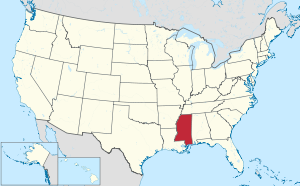
Back مقاطعة كليبورن (ميسيسيبي) Arabic Claiborne County, Mississippi BAR Клейборн (окръг, Мисисипи) Bulgarian ক্লাইবোর্ন কাউন্টি, মিসিসিপি BPY Claiborne Gông (Mississippi) CDO Клейборн (гуо, Миссисипи) CE Claiborne County (kondado sa Tinipong Bansa, Mississippi) CEB Claiborne County, Mississippi Welsh Claiborne County (Mississippi) Danish Claiborne County (Mississippi) German
Claiborne County | |
|---|---|
 Claiborne County courthouse and Confederate Monument in Port Gibson | |
 Location within the U.S. state of Mississippi | |
 Mississippi's location within the U.S. | |
| Coordinates: 31°58′N 90°55′W / 31.97°N 90.91°W | |
| Country | |
| State | |
| Founded | 1802 |
| Named for | William C. C. Claiborne |
| Seat | Port Gibson |
| Largest city | Port Gibson |
| Area | |
• Total | 501 sq mi (1,300 km2) |
| • Land | 487 sq mi (1,260 km2) |
| • Water | 14 sq mi (40 km2) 2.8% |
| Population (2020) | |
• Total | 9,135 |
| • Density | 18/sq mi (7.0/km2) |
| Time zone | UTC−6 (Central) |
| • Summer (DST) | UTC−5 (CDT) |
| Congressional district | 2nd |
| Website | ccmsgov.us |
Claiborne County is a county located in the U.S. state of Mississippi. As of the 2020 census, the population was 9,135.[1] Its county seat is Port Gibson.[2] The county is named after William Claiborne, the second governor of the Mississippi Territory.
Claiborne County is included in the Vicksburg, MS Micropolitan Statistical Area as well as the Jackson-Vicksburg-Brookhaven, MS Combined Statistical Area. It is bordered by the Mississippi River on the west and the Big Black River on the north.
As of the 2020 Census, this small county has the highest percentage of black or African American residents of any U.S. county, at 88.6% of the population.[3] Located just south of the area known as the Mississippi Delta, this area also was a center of cotton plantations and related agriculture along the river, supported by enslaved African Americans. After emancipation, many generations of African Americans have stayed here because of family ties and having made the land their own.
Claiborne County was the center of a little-known but profound demonstration and struggle during the civil rights movement.[4]
- ^ "State & County QuickFacts". United States Census Bureau. Archived from the original on June 7, 2011. Retrieved October 26, 2021.
- ^ "Find a County". National Association of Counties. Archived from the original on May 31, 2011. Retrieved June 7, 2011.
- ^ "Minorities now in the majority in nearly 10% of U.S. counties", Lexington Herald-Leader August 8, 2007, p. A8
- ^ Crosby, Emilye (2006). Little Taste of Freedom: The Black Freedom Struggle in Claiborne County, Mississippi. University of North Carolina Press. ISBN 9780807856383.